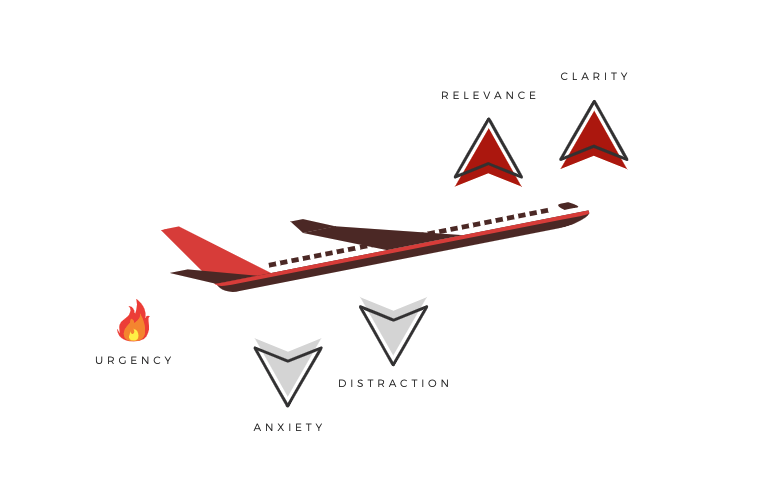Today the average internet user has the attention span of a goldfish… if you’re lucky.
High-performing content hooks your audience, makes them stick, and gets them to take action.
Take a look at the content spectrum.
- Normal: “Meh… I already knew that.”
- Interactive: “Yea… I like this. I’ll check it out further.”
- High-performing: “Wow! Let’s do this! Tell me how!!”
Normal content fails to create a lasting impression. High-performing content produces measurable results and revenue.
So are you ready to create high-performing content? Here are 3 quick tips:
1. Understand what your audience wants
2. Evaluate the performance of your content with the LIFT model
3. Make your content actionable
1. Understand what your audience wants
When it comes to converting customers, here’s a simple secret: understand what your buyer desperately wants.
First, conduct some content and keyword research so you can write about topics that your audience is actually interested in. Here are some of our best keyword research tools:
- Keywordtool.io: This helps you find great keywords using Google autocomplete (and what real readers are searching for!)
- Google Keyword Planner: This popular tool is used to find the right words and phrases for Google Ads campaigns and YouTube SEO. It’s designed to help you discover new keywords that are relevant for your business, give you insight into how often certain words are searched and show you how those searches have changed over time. You need to set up a Google AdWords account to get access.
-
Keyword.io: This free alternative to Google Keyword Planner for SEO & PPC keyword research generates thousands of long-tail keywords in seconds!
- Keywords Everywhere: This browser add-on for Chrome & Firefox shows search volume, CPC, and competition on multiple websites.
See more of our top 2021 productivity tools.
2. Evaluate the performance of your content with the LIFT model

The LIFT model allows you to evaluate the performance of any copy, content, or marketing asset from your target audience’s perspective. It’s based on 6 conversion factors – value proposition, clarity, relevance, distraction, anxiety, and urgency.
Value Proposition
Your value proposition tells prospects why they should do business with you.
When writing for the web and formatting content, here are some key considerations:
- Include your value proposition in a high-contrast, left-justified headline of two lines or less
- Consider the eye-flow, design, imagery, copywriting, and calls-to-action
- Try not to use more than 3 fonts on a webpage
- Cut your copy in half
- Enlarge your action buttons
- Reduce the number of form fields
- Minimize the number of layout columns
- Be mindful of the header hierarchy: headline, subheading, paragraphs, etc.
Clarity
Are your benefits clear? Avoid jargon.
98% of surveyed consumers said they respond positively to simple messages over slogans. Use industry stats instead of vague terms, buzzwords, and meaningless “corporate speak.” This is one of the most effective ways to persuade people.
Relevance
Does your content deliver on what your prospects expect? Does your copy match their needs? Do you resonate with their pain or aspirations?
Distraction
Anything that diverts people away from your primary goal is a distraction. Here are some questions to ask yourself:
- What’s not helping your prospect take action?
- What can I remove without compromising performance?
- Is anything drawing attention unnecessarily?
On website content, watch out for:
- Large navigations that take up lots of screen space
- Popups and social media icons
- Distracting fonts and colors
- Unrelated copy
- Additional calls-to-action with high contrast colors
- Moving images, flashing advertisements, and auto-play videos
Anxiety
Are there elements that could be creating uncertainty for your prospects about taking action?
Urgency
When you impose limited availability or time on your offers, people respond. Nobody wants to miss out on a valuable resource. Scarcity increases the value of your offer and creates a sense of urgency.
Amazon uses urgency effectively in its product pages.
3. Make your content actionable
Actionable content is meaningful, memorable, relevant, relatable, and tailored to your target audience.
Here are 3 simple ways to make your content more actionable content:
- Use visuals (images and videos)
- Write with a personal touch
- Answer common questions or issues
Really want to make actionable content? Don’t just tell what to do, explain how to.
Here are some examples
Before: “My struggle as an artist.”
After: “The step-by-step method for going from starving artist to thriving creator.”
That first headline feels like some kind of sob story, but in the after you know you’re going to hear a story and learn something actionable.
Before: “Be careful before you hire a CPA.”
After: “Warning: 5 must-ask questions to ask before you hire a CPA.”
The first one may get your attention but with the second you know you’ll have a clear checklist that sets you up to work with any CPA.
Before “I hope you enjoyed this article about creating trust..”
After: “Leave a comment with 3 examples of companies you consider to be trustworthy and why.”
Can you see how that second example prompts people to take a specific action? It tells them exactly what they should do. You’ll create a lot of engagement and dialogue around that piece of content.
Alright! So there you have it. Hope you enjoyed reading this blog as much as we enjoyed putting it together for you ❤️. Our team is committed to helping you grow your business with excellent digital marketing strategy and execution. If you’re ready to engage your customers with compelling content that drives participation, we can help. Just book a call.






